Influence of the Crack Angle on the Deformation and Failure Characteristics of Sandstone under Stepped Cyclic Uniaxial Compression with a Constant Lower Limit
Abstract
:1. Introduction
2. Experimental Material and Setup
2.1. Specimen Preparation
2.2. Test Equipment
2.3. Test Procedures
3. Calculation Methods of the Mechanical and Deformation Parameters
3.1. Irreversible Plastic Strain
3.2. Elastic Modulus
4. Test Results and Discussion
4.1. Stress–Strain Curves
4.2. Influence of the Crack Angle on the Peak Stress
4.3. Influence of the Crack Angle on the Irreversible Deformation
4.4. Influence of the Crack Angle on the Elastic Moduli
4.5. Influence of the Crack Angle on the Failure Mode of the Rock Specimens
5. Conclusions
- (1)
- It was found that the bearing capacity of the sandstone increased gradually as the crack angle increased. The bearing capacity of the pre-cracked rock was sensitive to both the crack angle and the stress path. Compared to the crack angle, the stress path exerted a more pronounced effect on the peak stress of the pre-cracked rock. There was a strong linear relationship between the peak stress and the crack angle, which was closely related to the failure mode of the rock specimens. The presence of large angle cracks made the rock more prone to shear failure.
- (2)
- The irreversible deformation of the pre-cracked sandstone could be divided into three stages before rock failure (including the initial stage, the steady stage, and the accelerated stage), which separately corresponded to the three deformation stages of the rocks before failure. As the crack angle increased, the irreversible deformation gradually decreased.
- (3)
- Both the loading elastic modulus and the unloading elastic modulus increased as the crack angle increased during the stepped cyclic loading. The two types of elastic moduli showed a significant linear relationship with the crack angle. In addition, the whole stepped cyclic loading process of the specimen could be divided into three stages: the initial growth stage, the basically unchanged stage, and the significant decrease stage.
- (4)
- Under stepped cyclic uniaxial compression, the failure mode of the pre-cracked rock specimens was closely related to the crack angle. As the crack angle increased, the failure mode changed from the mixed tensile-shear failure to the shear failure and then to the interlayer dislocation failure.
Author Contributions
Funding
Institutional Review Board Statement
Informed Consent Statement
Data Availability Statement
Acknowledgments
Conflicts of Interest
References
- Wong, R.; Chau, K.; Tang, C.; Lin, P. Analysis of crack coalescence in rock-like materials containing three flaws—Part I: Experimental approach. Int. J. Rock Mech. Min. Sci. 2001, 38, 909–924. [Google Scholar] [CrossRef]
- Cao, P.; Liu, T.; Pu, C.; Lin, H. Crack propagation and coalescence of brittle rock-like specimens with pre-existing cracks in compression. Eng. Geol. 2014, 187, 113–121. [Google Scholar] [CrossRef]
- Luo, K.; Zhao, G.; Zeng, J.; Zhang, X.; Pu, C. Fracture experiments and numerical simulation of cracked body in rock-like materials affected by loading rate. Chin. J. Rock Mech. Eng. 2018, 37, 1833–1842. [Google Scholar] [CrossRef]
- Si, X.; Luo, S.; Luo, Y. A Review of Mechanical Properties and Rockburst Investigation of Transversely Isotropic Rocks by Experimental Technique. Materials 2023, 16, 3183. [Google Scholar] [CrossRef]
- Si, X.; Li, X.; Gong, F.; Huang, L.; Ma, C. Experimental investigation on rockburst process and characteristics of a circular opening in layered rock under three-dimensional stress conditions. Tunn. Undergr. Space Technol. 2022, 127, 104603. [Google Scholar] [CrossRef]
- Dai, B.; Zhao, G.; Zhang, L.; Liu, Y.; Zhang, Z.; Luo, X.; Chen, Y. Energy Dissipation of Rock with Different Parallel Flaw Inclinations under Dynamic and Static Combined Loading. Mathematics 2022, 10, 4082. [Google Scholar] [CrossRef]
- Feng, X.-T.; Guo, H.-S.; Yang, C.-X.; Li, S.-J. In situ observation and evaluation of zonal disintegration affected by existing fractures in deep hard rock tunneling. Eng. Geol. 2018, 242, 1–11. [Google Scholar] [CrossRef]
- Zhou, Y.-Y.; Xu, D.-P.; Gu, G.-K.; Liu, K.; Wan, L.-P.; Wang, T.-L.; Yang, J.-B. The failure mechanism and construction practice of large underground caverns in steeply dipping layered rock masses. Eng. Geol. 2019, 250, 45–64. [Google Scholar] [CrossRef]
- Gong, F.-Q.; Si, X.-F.; Li, X.-B.; Wang, S.-Y. Dynamic triaxial compression tests on sandstone at high strain rates and low confining pressures with split Hopkinson pressure bar. Int. J. Rock Mech. Min. Sci. 2018, 113, 211–219. [Google Scholar] [CrossRef]
- Elmo, D.; Donati, D.; Stead, D. Challenges in the characterisation of intact rock bridges in rock slopes. Eng. Geol. 2018, 245, 81–96. [Google Scholar] [CrossRef]
- Zheng, Y.; Chen, C.; Liu, T.; Song, D.; Meng, F. Stability analysis of anti-dip bedding rock slopes locally reinforced by rock bolts. Eng. Geol. 2019, 251, 228–240. [Google Scholar] [CrossRef]
- Yang, S.-Q.; Jing, H.-W. Strength failure and crack coalescence behavior of brittle sandstone samples containing a single fissure under uniaxial compression. Int. J. Fract. 2010, 168, 227–250. [Google Scholar] [CrossRef]
- Yang, S.-Q. Crack coalescence behavior of brittle sandstone samples containing two coplanar fissures in the process of deformation failure. Eng. Fract. Mech. 2011, 78, 3059–3081. [Google Scholar] [CrossRef]
- Yang, S.Q.; Yang, D.S.; Jing, H.W.; Li, Y.H.; Wang, S. An Experimental Study of the Fracture Coalescence Behaviour of Brittle Sandstone Specimens Containing Three Fissures. Rock Mech. Rock Eng. 2011, 45, 563–582. [Google Scholar] [CrossRef]
- Yang, S.-Q.; Jing, H.-W.; Huang, Y.-H.; Ranjith, P.; Jiao, Y.-Y. Fracture mechanical behavior of red sandstone containing a single fissure and two parallel fissures after exposure to different high temperature treatments. J. Struct. Geol. 2014, 69, 245–264. [Google Scholar] [CrossRef]
- Wang, D.-J.; Tang, H.; Elsworth, D.; Wang, C. Fracture evolution in artificial bedded rocks containing a structural flaw under uniaxial compression. Eng. Geol. 2019, 250, 130–141. [Google Scholar] [CrossRef]
- Wong, L.; Einstein, H. Systematic evaluation of cracking behavior in specimens containing single flaws under uniaxial compression. Int. J. Rock Mech. Min. Sci. 2008, 46, 239–249. [Google Scholar] [CrossRef]
- Yin, Q.; Jing, H.-W.; Zhu, T.-T. Experimental Study on Mechanical Properties and Cracking Behavior of Pre-cracked Sandstone Specimens Under Uniaxial Compression. Indian Geotech. J. 2016, 47, 265–279. [Google Scholar] [CrossRef]
- Xu, L.; Gong, F.; Luo, S. Effects of pre-existing single crack angle on mechanical behaviors and energy storage characteristics of red sandstone under uniaxial compression. Theor. Appl. Fract. Mech. 2021, 113, 102933. [Google Scholar] [CrossRef]
- Cao, R.H.; Cao, P.; Lin, H. Crack Coalescence and Failure Patterns in Brittle Rock-Like Specimens with Pre-Existing Fissures under Uniaxial Loading: Experimental Studies. Key Eng. Mater. 2015, 665, 117–120. [Google Scholar] [CrossRef]
- Pu, C.; Cao, P.; Yi, Y. Fracture for rock-like materials with two transfixion fissures under uniaxial compression. J. Cent. South Univ. 2012, 43, 2708–2716. [Google Scholar]
- Zhou, Z.; Zhang, J.; Cai, X.; Wang, S.; Du, X.; Zang, H.; Chen, L. Permeability Evolution of Fractured Rock Subjected to Cyclic Axial Load Conditions. Geofluids 2020, 2020, 1–12. [Google Scholar] [CrossRef]
- Wong, R.; Tang, C.; Chau, K.; Lin, P. Splitting failure in brittle rocks containing pre-existing flaws under uniaxial compression. Eng. Fract. Mech. 2002, 69, 1853–1871. [Google Scholar] [CrossRef]
- Zhang, X.-P.; Wong, L.N.Y. Cracking Processes in Rock-Like Material Containing a Single Flaw Under Uniaxial Compression: A Numerical Study Based on Parallel Bonded-Particle Model Approach. Rock Mech. Rock Eng. 2011, 45, 711–737. [Google Scholar] [CrossRef]
- Zhou, X.P.; Bi, J.; Qian, Q.H. Numerical Simulation of Crack Growth and Coalescence in Rock-Like Materials Containing Multiple Pre-existing Flaws. Rock Mech. Rock Eng. 2014, 48, 1097–1114. [Google Scholar] [CrossRef]
- Peng, K.; Lv, H.; Zou, Q.; Wen, Z.; Zhang, Y. Evolutionary characteristics of mode-I fracture toughness and fracture energy in granite from different burial depths under high-temperature effect. Eng. Fract. Mech. 2020, 239, 107306. [Google Scholar] [CrossRef]
- Huang, D.; Cen, F.; Huang, R.Q. Influence of medium strain rate on sandstone with a single pre-crack under uniaxial compression using PFC simulation. Rock Soil Mech. 2013, 34, 535–545. [Google Scholar] [CrossRef]
- Wu, Q.; Weng, L.; Zhao, Y.; Zhao, F.; Peng, W.; Zhang, S. Deformation and cracking characteristics of ring-shaped granite with inclusion under diametrical compression. Arab. J. Geosci. 2020, 13, 1–11. [Google Scholar] [CrossRef]
- Wu, Q.-H.; Weng, L.; Zhao, Y.-L.; Feng, F. Influence of infilling stiffness on mechanical and fracturing responses of hollow cylindrical sandstone under uniaxial compression tests. J. Cent. South Univ. 2021, 28, 2485–2498. [Google Scholar] [CrossRef]
- Lin, Q.; Cao, P.; Mao, S.; Ou, C.; Cao, R. Fatigue behaviour and constitutive model of yellow sandstone containing pre-existing surface crack under uniaxial cyclic loading. Theor. Appl. Fract. Mech. 2020, 109, 102776. [Google Scholar] [CrossRef]
- Lin, Q.; Cao, P.; Cao, R.; Lin, H.; Meng, J. Mechanical behavior around double circular openings in a jointed rock mass under uniaxial compression. Arch. Civ. Mech. Eng. 2020, 20, 19. [Google Scholar] [CrossRef]
- Dai, B.; Chen, Y.; Zhao, G.; Liang, W.; Wu, H. A Numerical Study on the Crack Development Behavior of Rock-Like Material Containing Two Intersecting Flaws. Mathematics 2019, 7, 1223. [Google Scholar] [CrossRef]
- Chen, B.; Gong, B.; Wang, S.; Tang, C. Research on Zonal Disintegration Characteristics and Failure Mechanisms of Deep Tunnel in Jointed Rock Mass with Strength Reduction Method. Mathematics 2022, 10, 922. [Google Scholar] [CrossRef]
- Shang, Y.; Kong, D.; Pu, S.; Xiong, Y.; Li, Q.; Cheng, Z. Study on Failure Characteristics and Control Technology of Roadway Surrounding Rock under Repeated Mining in Close-Distance Coal Seam. Mathematics 2022, 10, 2166. [Google Scholar] [CrossRef]
- Wang, Y.-Q.; Peng, K.; Shang, X.-Y.; Li, L.-P.; Liu, Z.-P.; Wu, Y.; Long, K. Experimental and numerical simulation study of crack coalescence modes and microcrack propagation law of fissured sandstone under uniaxial compression. Theor. Appl. Fract. Mech. 2021, 115, 103060. [Google Scholar] [CrossRef]
- Peng, K.; Wang, Y.; Zou, Q.; Cheng, Y.; Song, X. Experimental study of energy dissipation characteristics and crack coalescence modes of cracked sandstone under different cyclic loading paths. Bull. Eng. Geol. Environ. 2021, 80, 5881–5895. [Google Scholar] [CrossRef]
- Luo, S.; Gong, F. Evaluation of energy storage and release potentials of highly stressed rock pillar from rockburst control perspectives. Int. J. Rock Mech. Min. Sci. 2023, 163, 105324. [Google Scholar] [CrossRef]
- Luo, S.; Gong, F.Q.; Li, L.L.; Peng, K. Linear energy storage and dissipation laws and damage evolution characteristics of rock under triaxial cyclic compression with different confining pressure. Trans. Nonferrous Met. Soc. China 2022, 10, 1–27. Available online: https://kns.cnki.net/kcms/detail/43.1239.TG.20220630.1050.010.html (accessed on 1 July 2022).
- Xia, B.; Li, Y.; Hu, H.; Luo, Y.; Peng, J. Effect of Crack Angle on Mechanical Behaviors and Damage Evolution Characteristics of Sandstone Under Uniaxial Compression. Rock Mech. Rock Eng. 2022, 55, 6567–6582. [Google Scholar] [CrossRef]
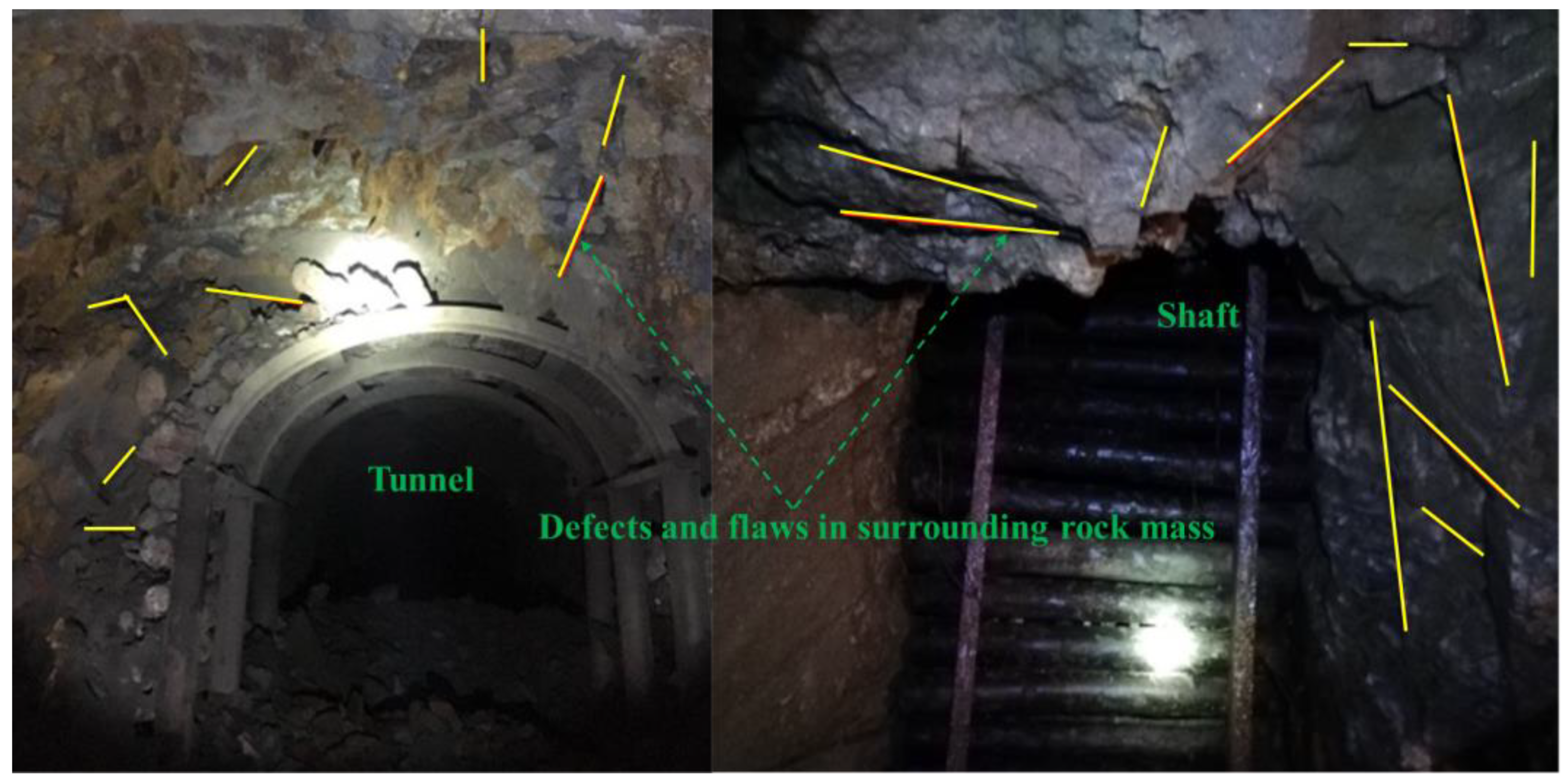
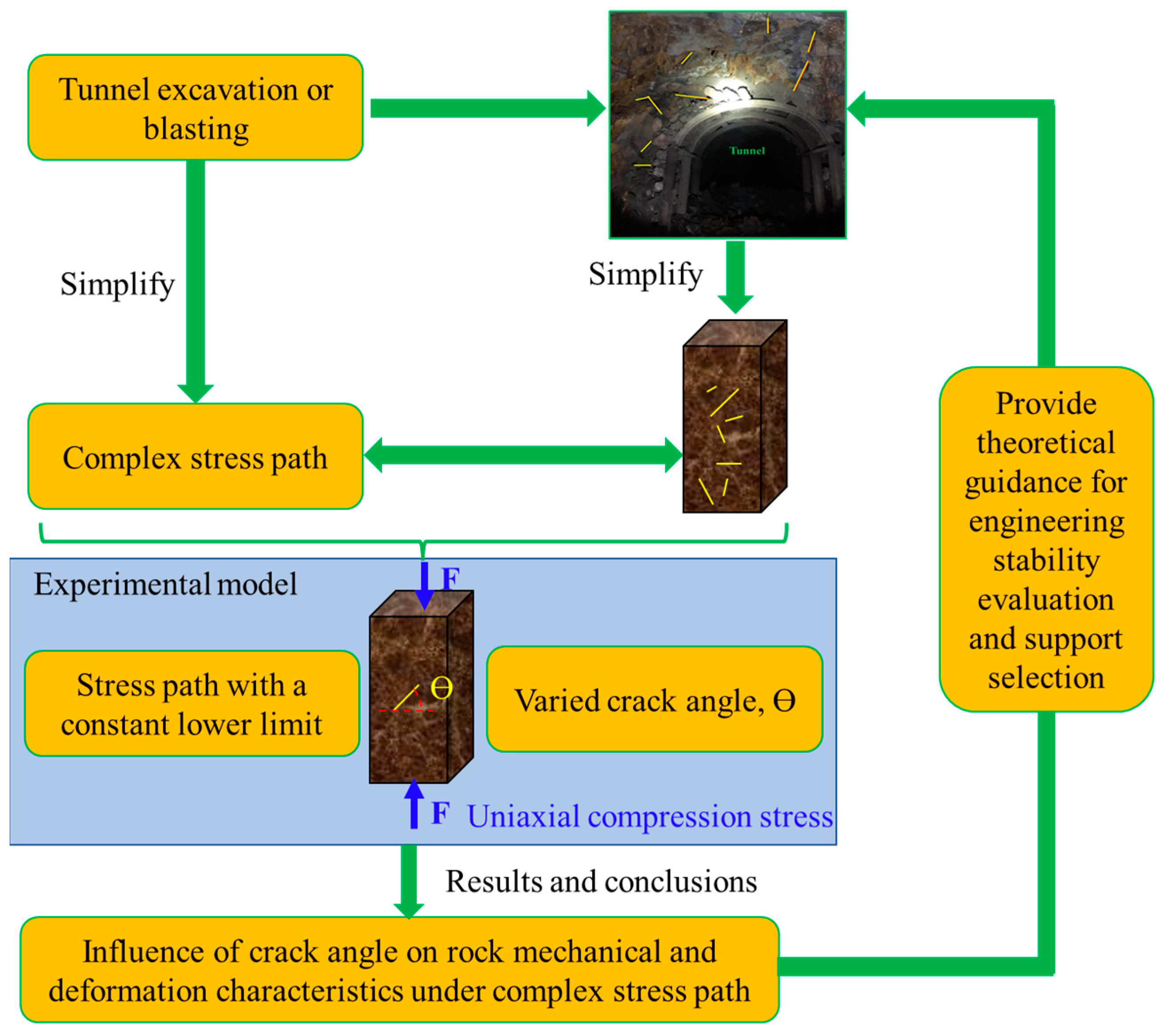

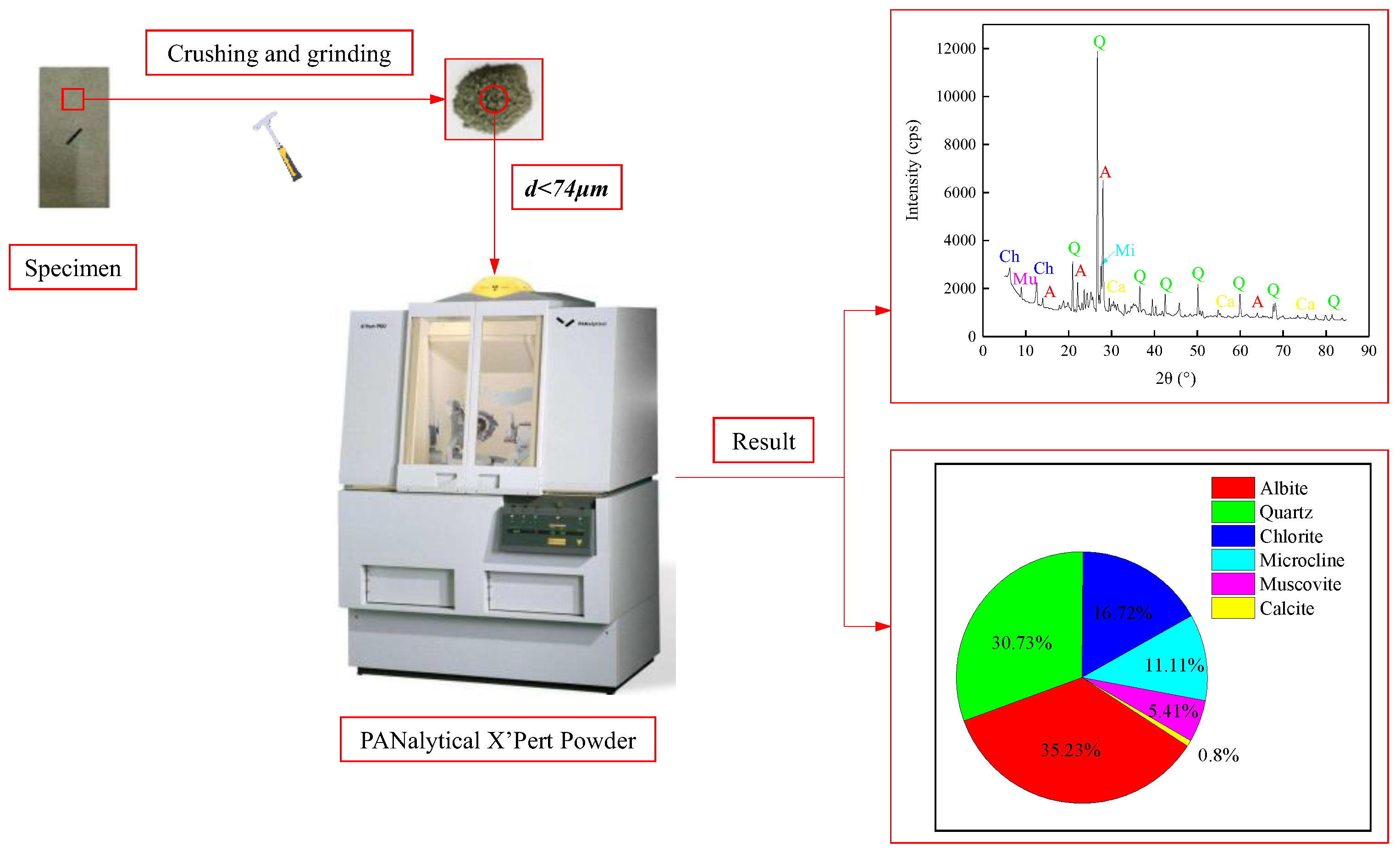
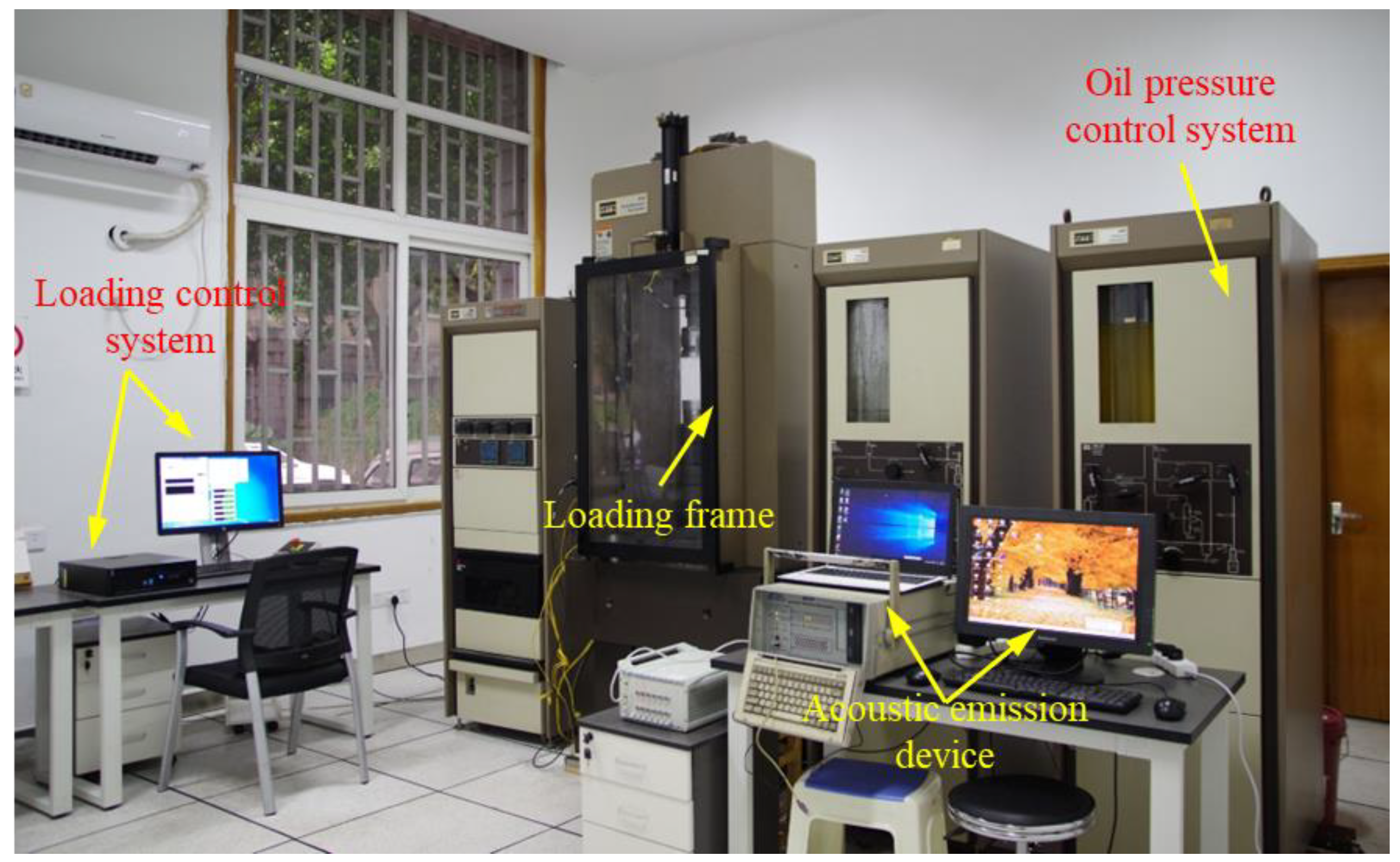
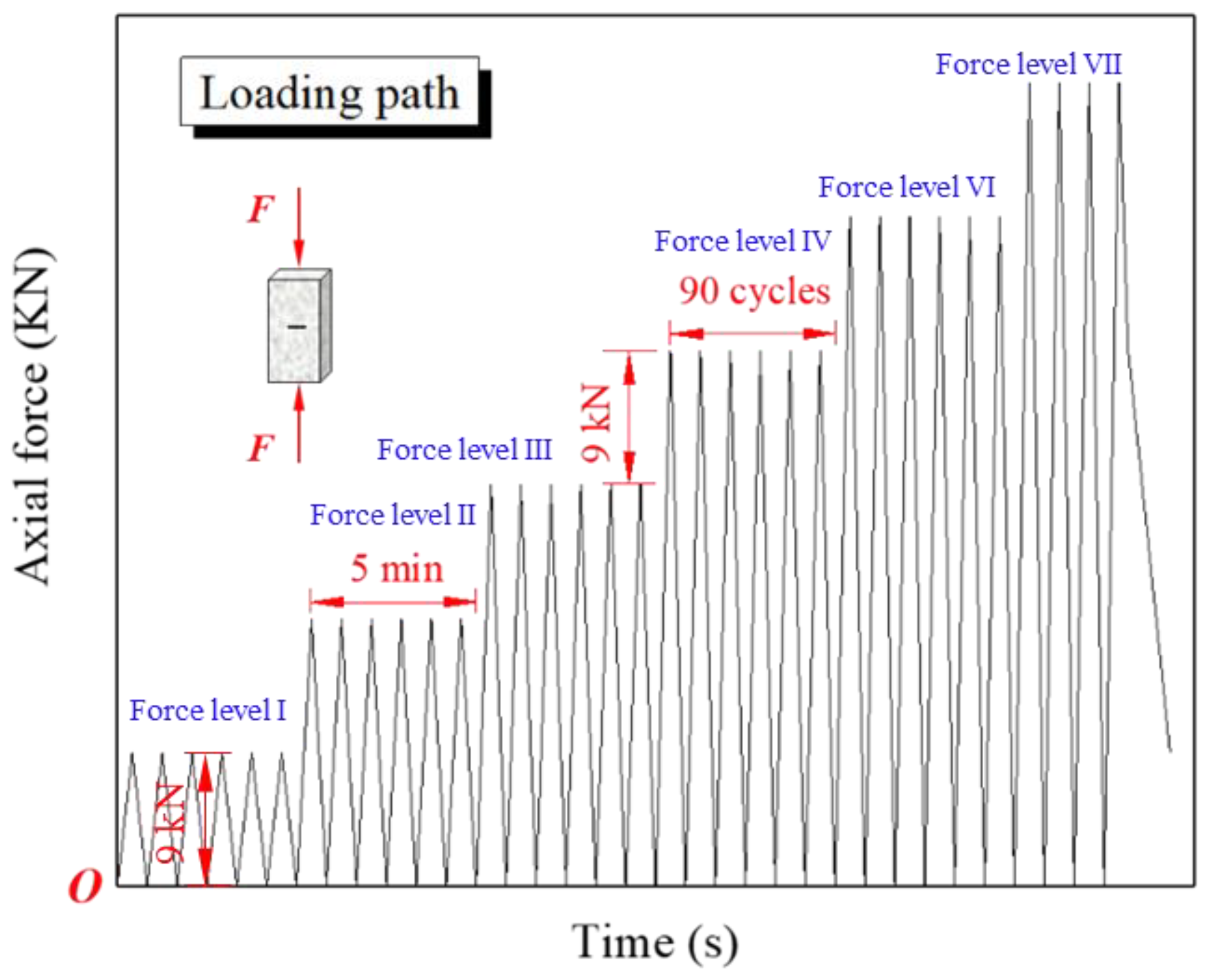
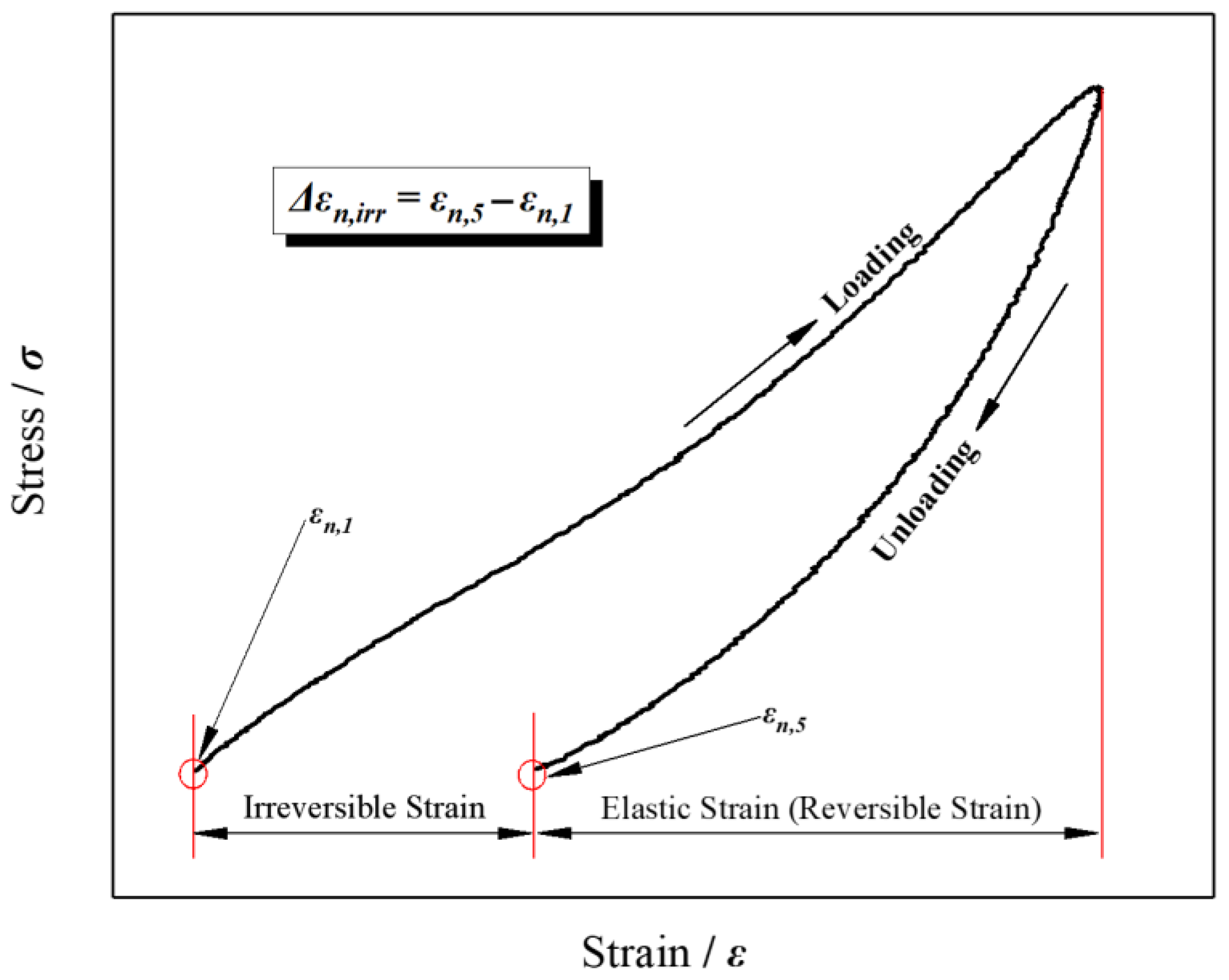

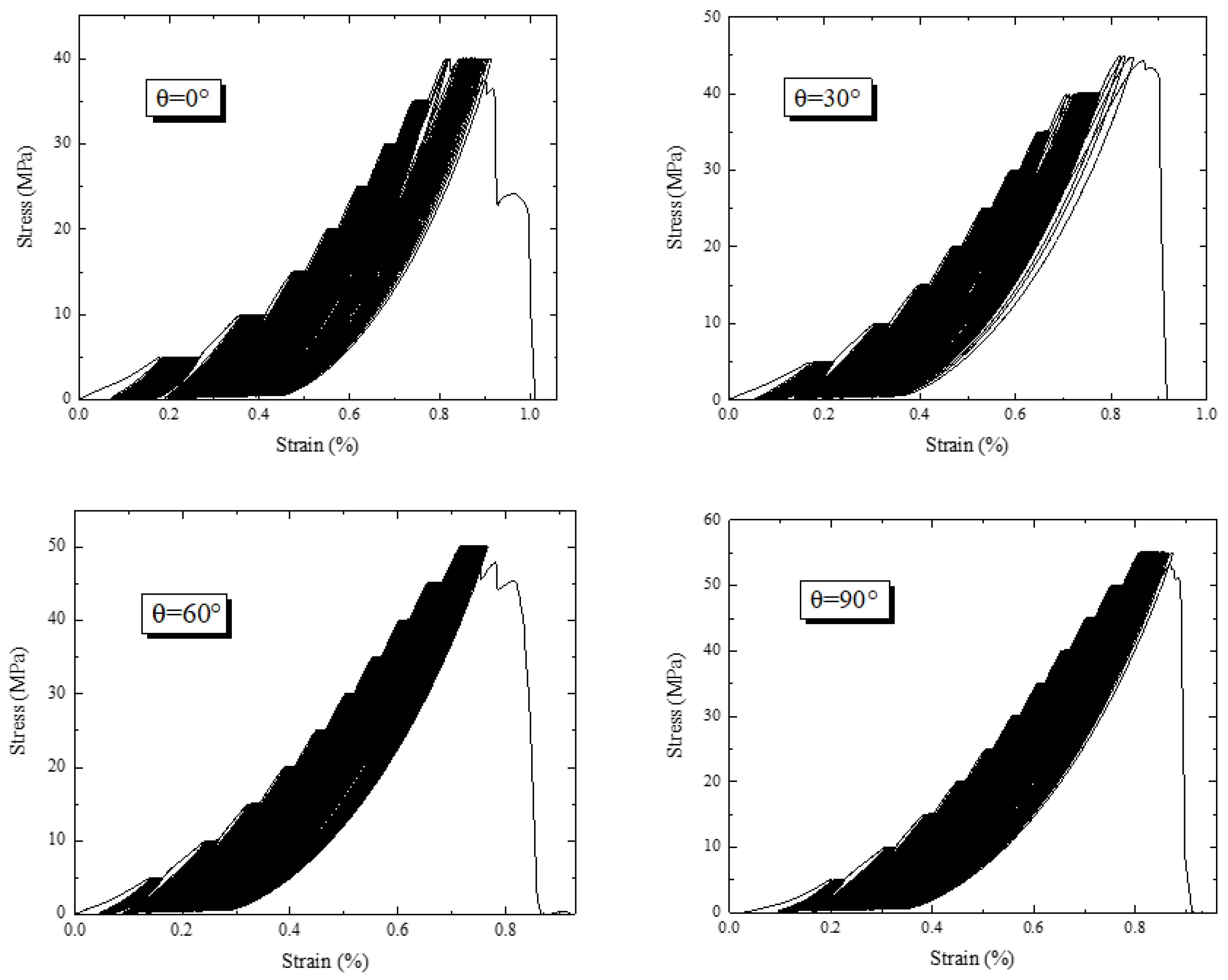
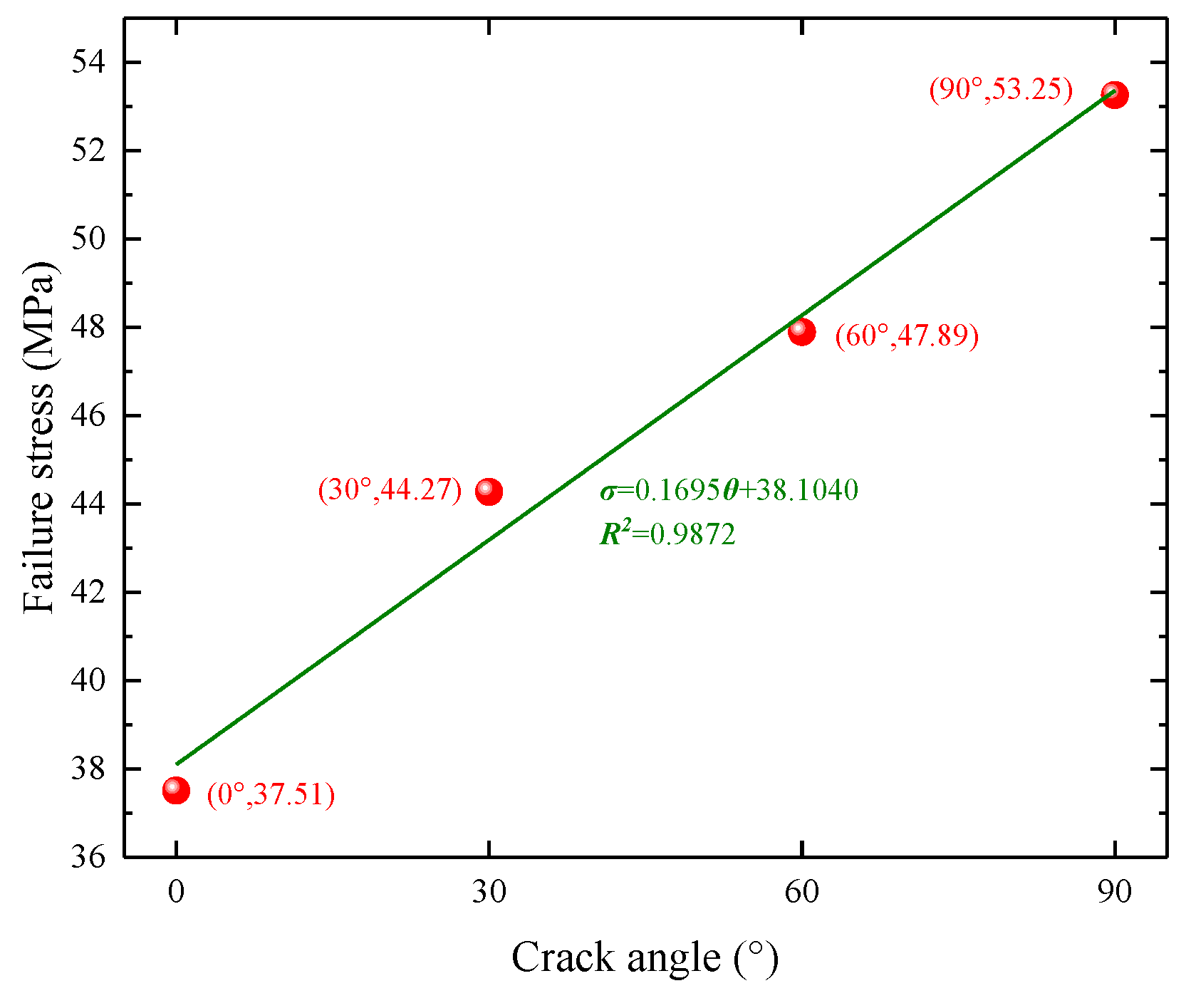

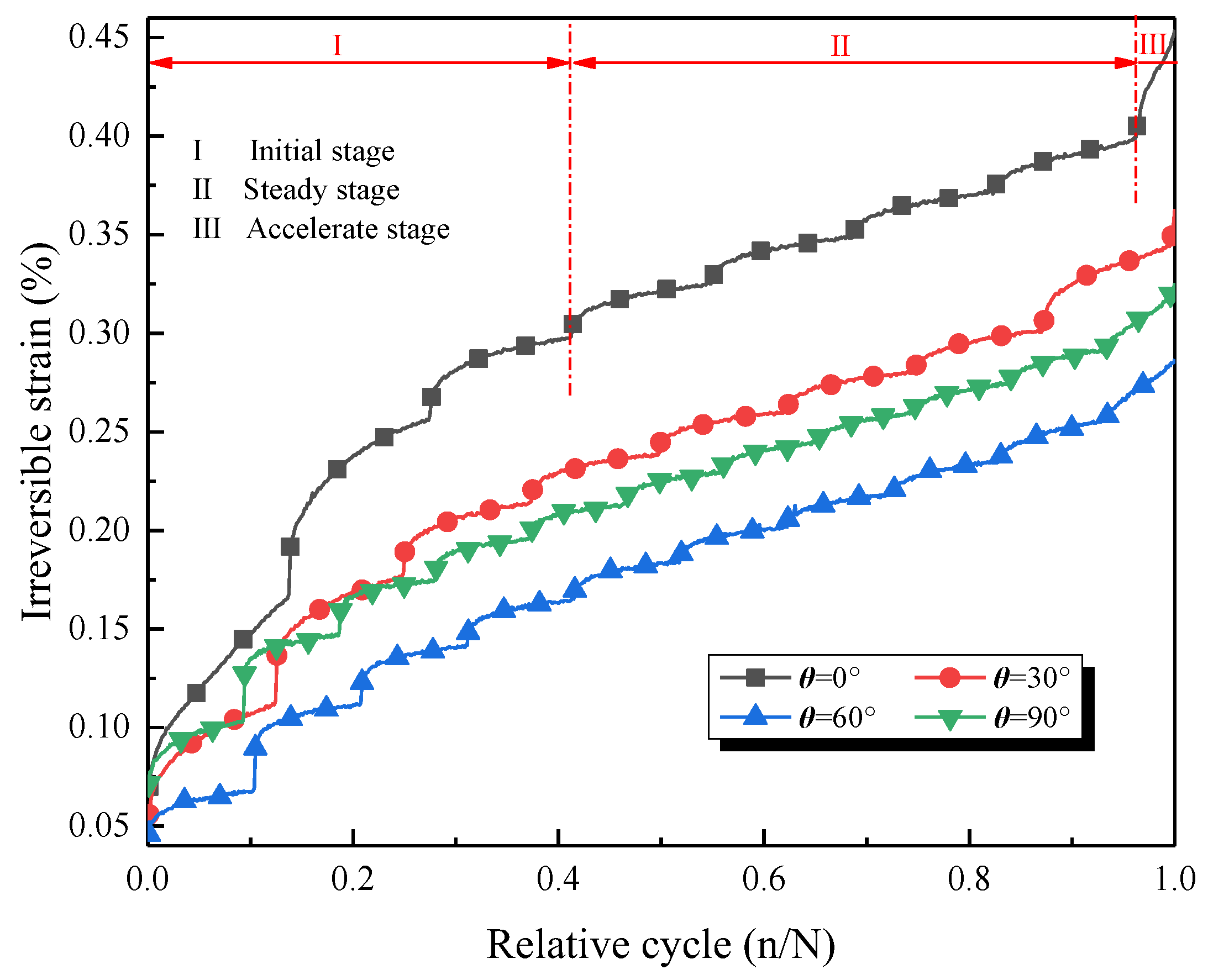
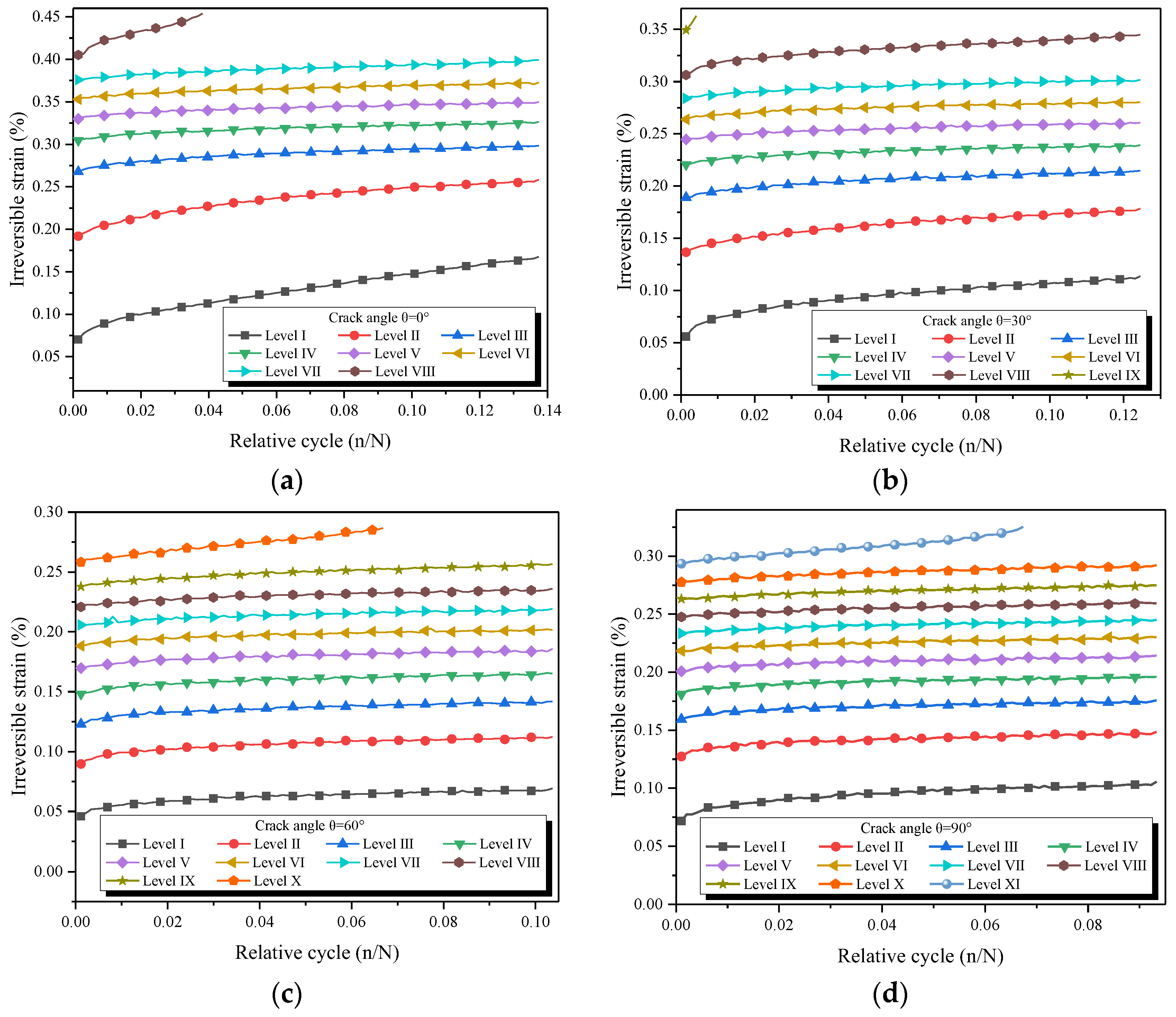
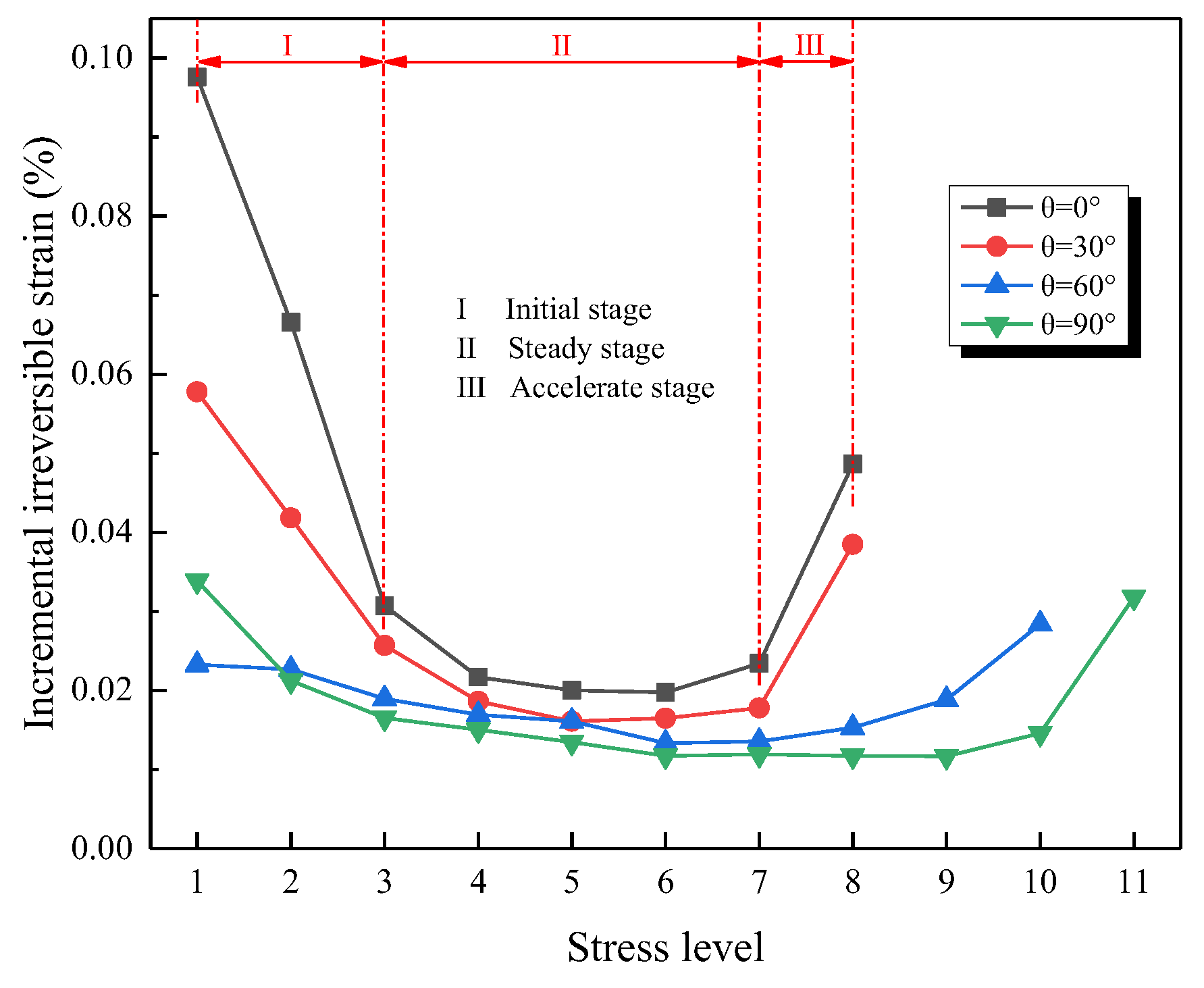
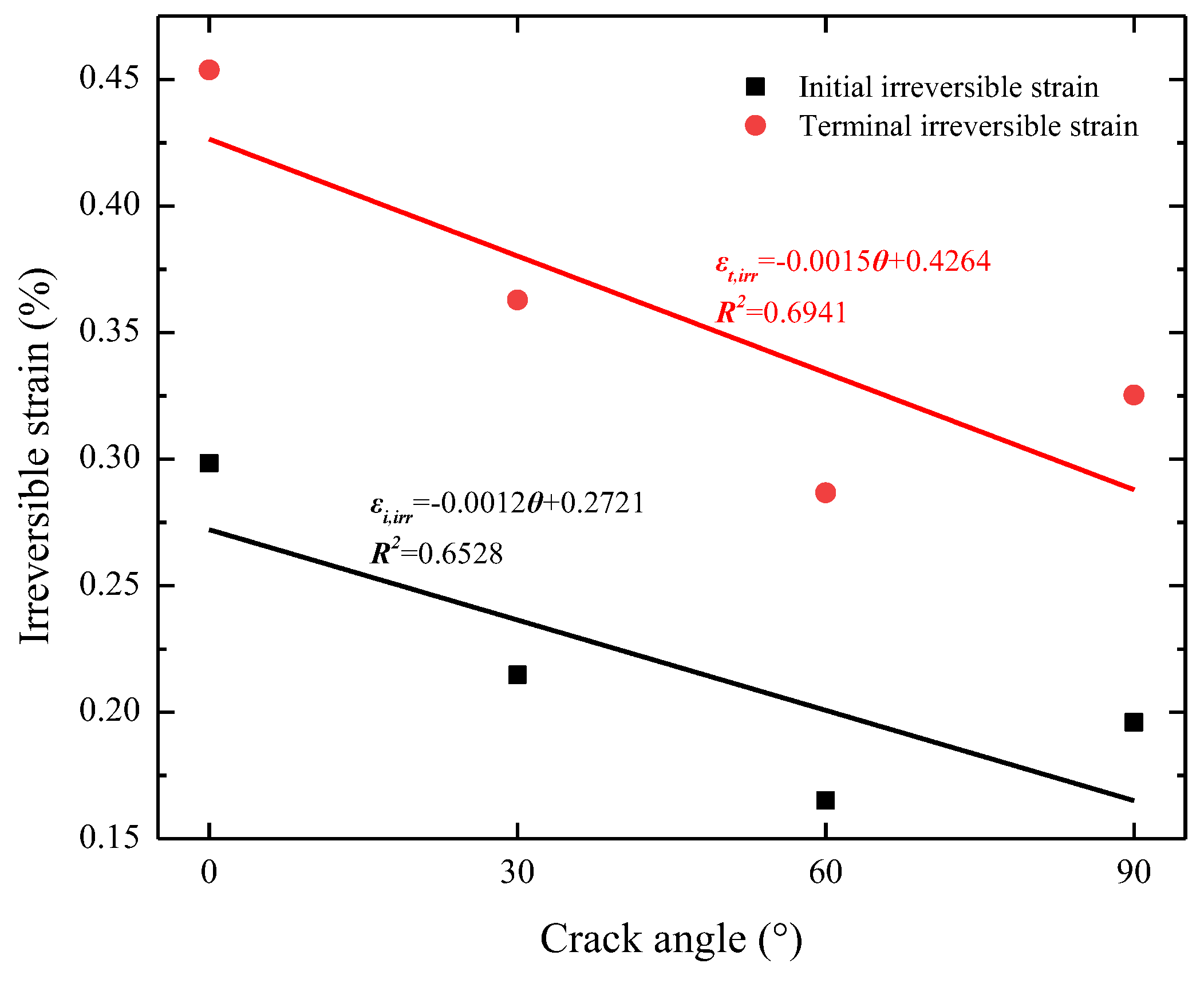
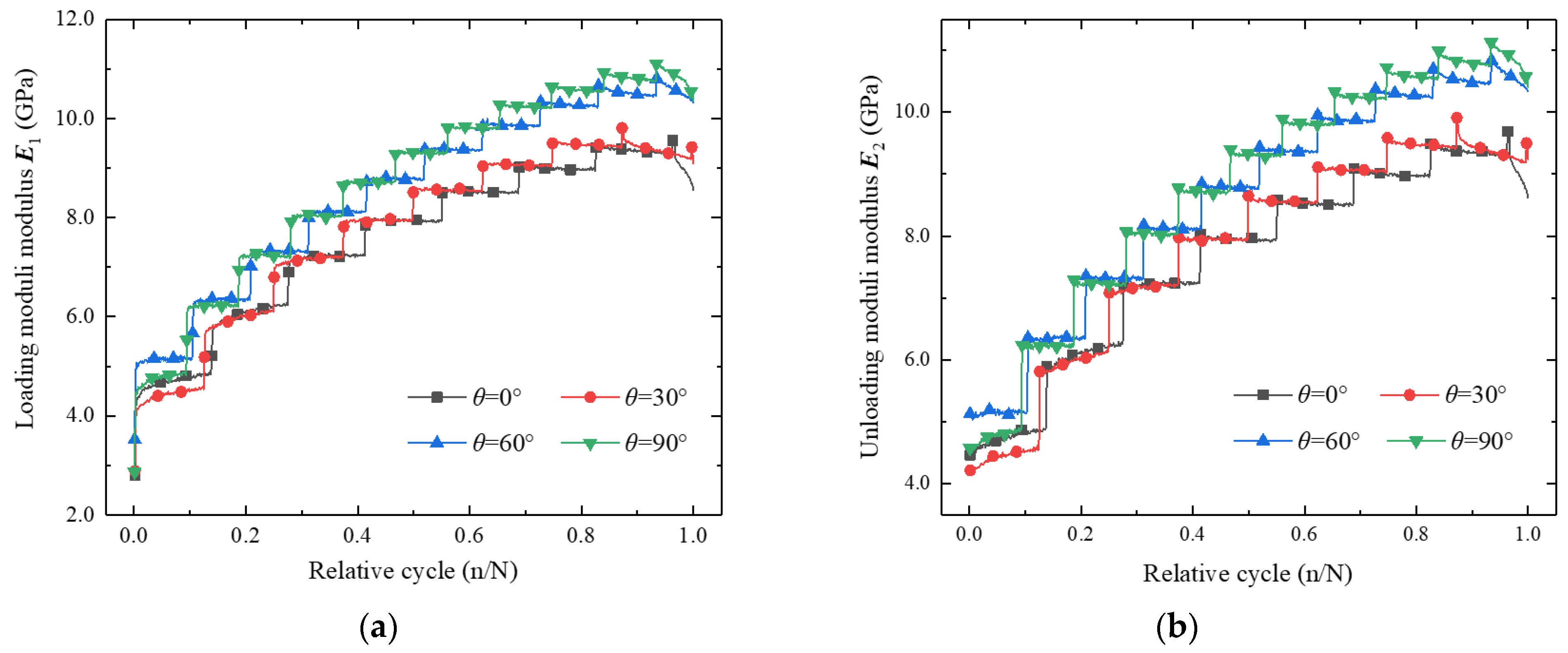
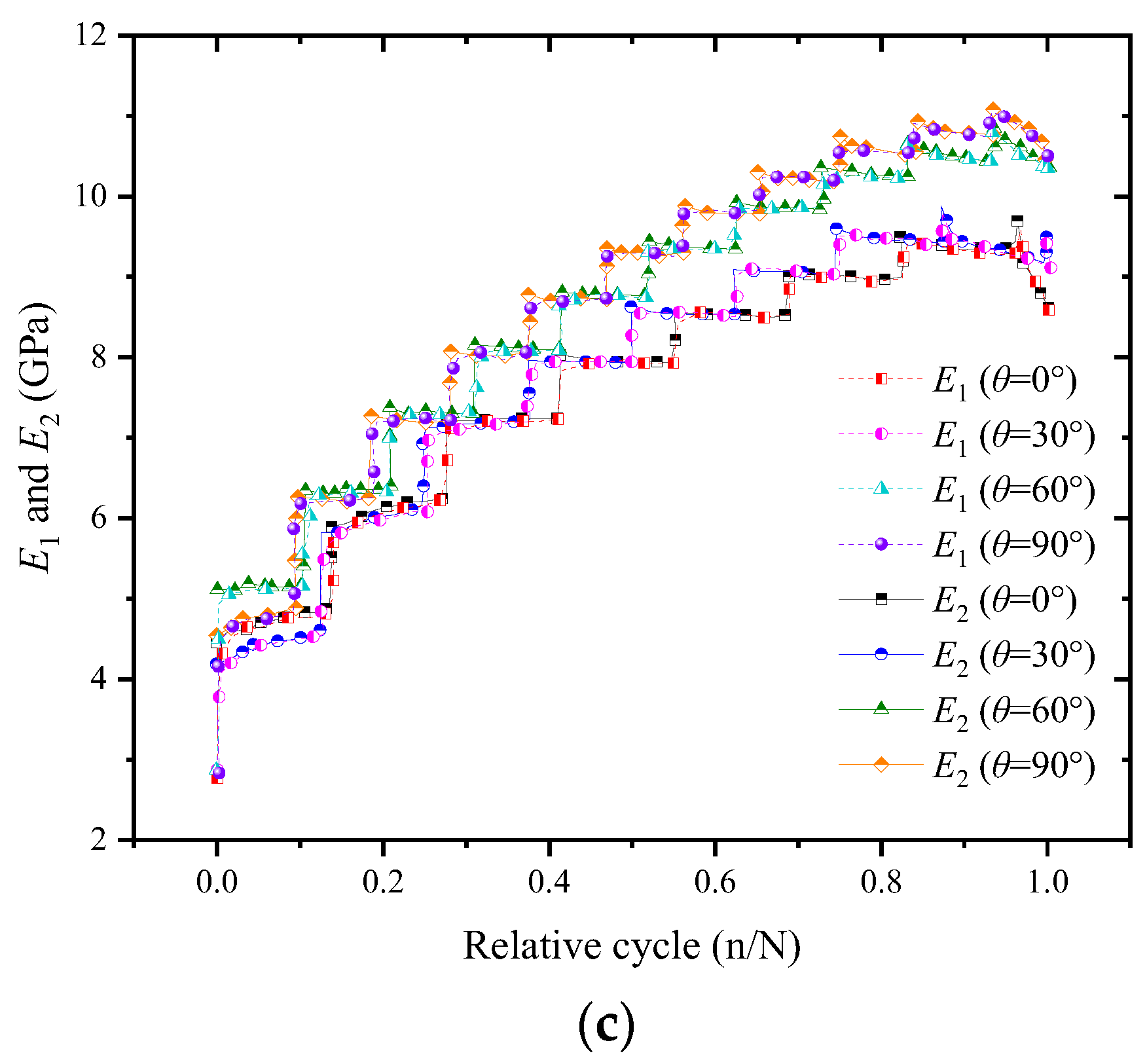


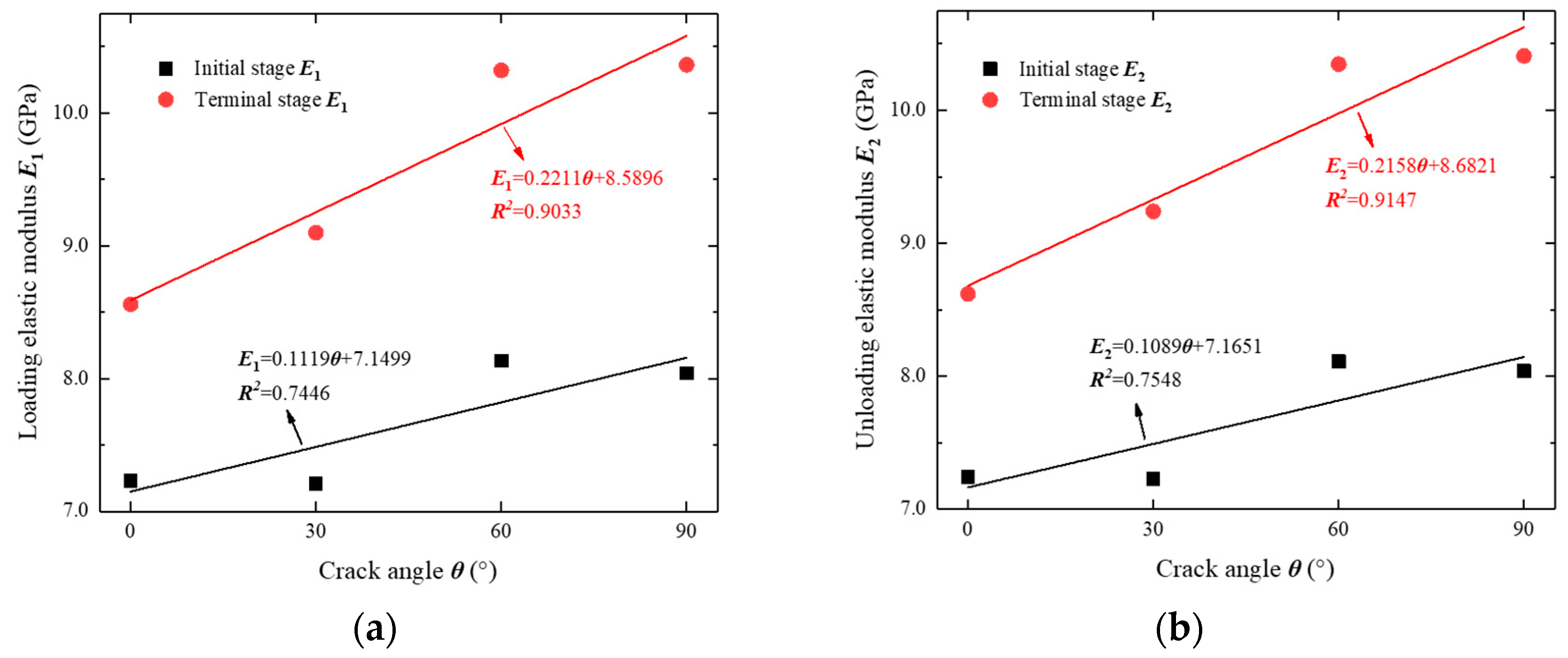

| Specimen No. | T-0 | T-30 | T-60 | T-90 |
|---|---|---|---|---|
| Crack angle/θ | 0° | 30° | 60° | 90° |
| Crack length L = 15 mm—Crack breadth B = 3 mm | ||||
| Specimen No. | Failure Stress/MPa | Failure Strain/% | Cycle Number /n | Total Number of Force Levels |
|---|---|---|---|---|
| T-0 | 37.51 | 0.90 | 655 | 8 |
| T-30 | 44.27 | 0.87 | 723 | 9 |
| T-60 | 47.89 | 0.78 | 868 | 10 |
| T-90 | 53.25 | 0.87 | 965 | 11 |
| References | Specimen Dimensions/mm3 | Crack Length /mm | Test Type |
|---|---|---|---|
| Yang et al. [12] | 30 × 60 × 120 | 15 | Monotonic uniaxial compression |
| Huang et al. [27] | 50 × 50 × 100 | 15 | Monotonic uniaxial compression |
| Xia et al. [39] | Φ50 × 100 | 15 | Monotonic uniaxial compression |
| Specimen No. | The Initial Stage | The Steady Stage | The Accelerated Stage |
|---|---|---|---|
| T-0 | Levels I~III | Levels IV~VII | Levels VIII |
| T-30 | Levels I~III | Levels IV~VII | Levels VIII~IX |
| T-60 | Levels I~VI | Levels V~IX | Level X |
| T-90 | Levels I~VI | Levels V~IX | Levels X~XI |
| Specimen No. | Initial Growth | Basically Unchanged | Great Reduction |
|---|---|---|---|
| T-0 | Levels I~III | Levels IV~VII | Levels VIII |
| T-30 | Levels I~III | Levels IV~VII | Levels VIII~IX |
| T-60 | Levels I~VI | Levels V~IX | Level X |
| T-90 | Levels I~VI | Levels V~IX | Levels X~XI |
Disclaimer/Publisher’s Note: The statements, opinions and data contained in all publications are solely those of the individual author(s) and contributor(s) and not of MDPI and/or the editor(s). MDPI and/or the editor(s) disclaim responsibility for any injury to people or property resulting from any ideas, methods, instructions or products referred to in the content. |
© 2023 by the authors. Licensee MDPI, Basel, Switzerland. This article is an open access article distributed under the terms and conditions of the Creative Commons Attribution (CC BY) license (https://creativecommons.org/licenses/by/4.0/).
Share and Cite
Wang, Y.; Wang, Y.; Luo, S.; Liu, H.; Yi, G.; Peng, K. Influence of the Crack Angle on the Deformation and Failure Characteristics of Sandstone under Stepped Cyclic Uniaxial Compression with a Constant Lower Limit. Mathematics 2023, 11, 2187. https://doi.org/10.3390/math11092187
Wang Y, Wang Y, Luo S, Liu H, Yi G, Peng K. Influence of the Crack Angle on the Deformation and Failure Characteristics of Sandstone under Stepped Cyclic Uniaxial Compression with a Constant Lower Limit. Mathematics. 2023; 11(9):2187. https://doi.org/10.3390/math11092187
Chicago/Turabian StyleWang, Yuanmin, Yunqiang Wang, Song Luo, Hao Liu, Guansheng Yi, and Kang Peng. 2023. "Influence of the Crack Angle on the Deformation and Failure Characteristics of Sandstone under Stepped Cyclic Uniaxial Compression with a Constant Lower Limit" Mathematics 11, no. 9: 2187. https://doi.org/10.3390/math11092187






